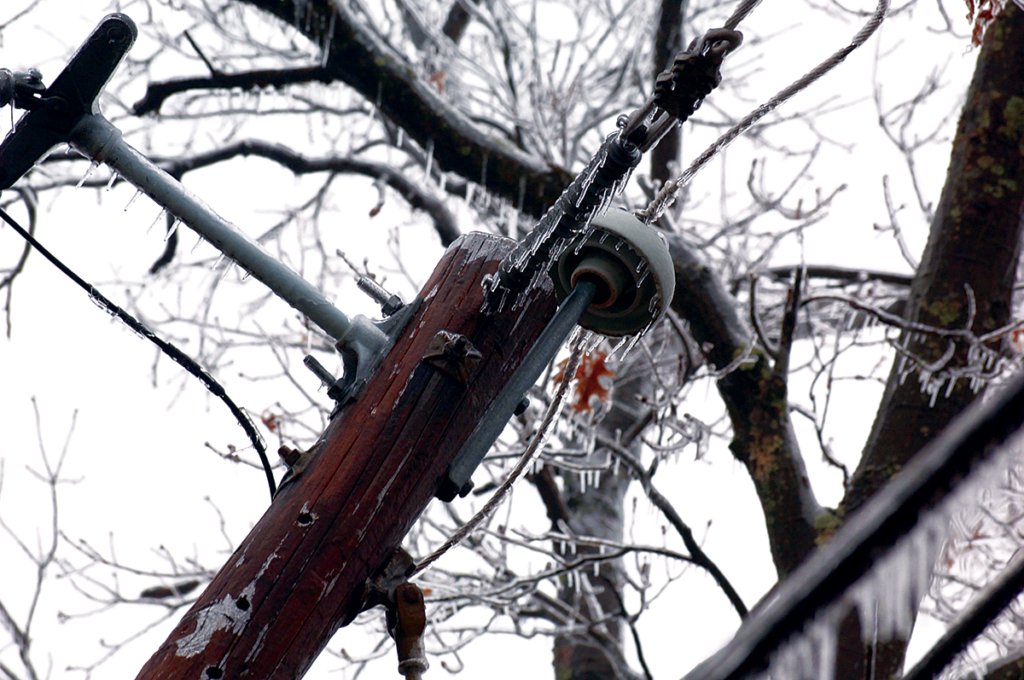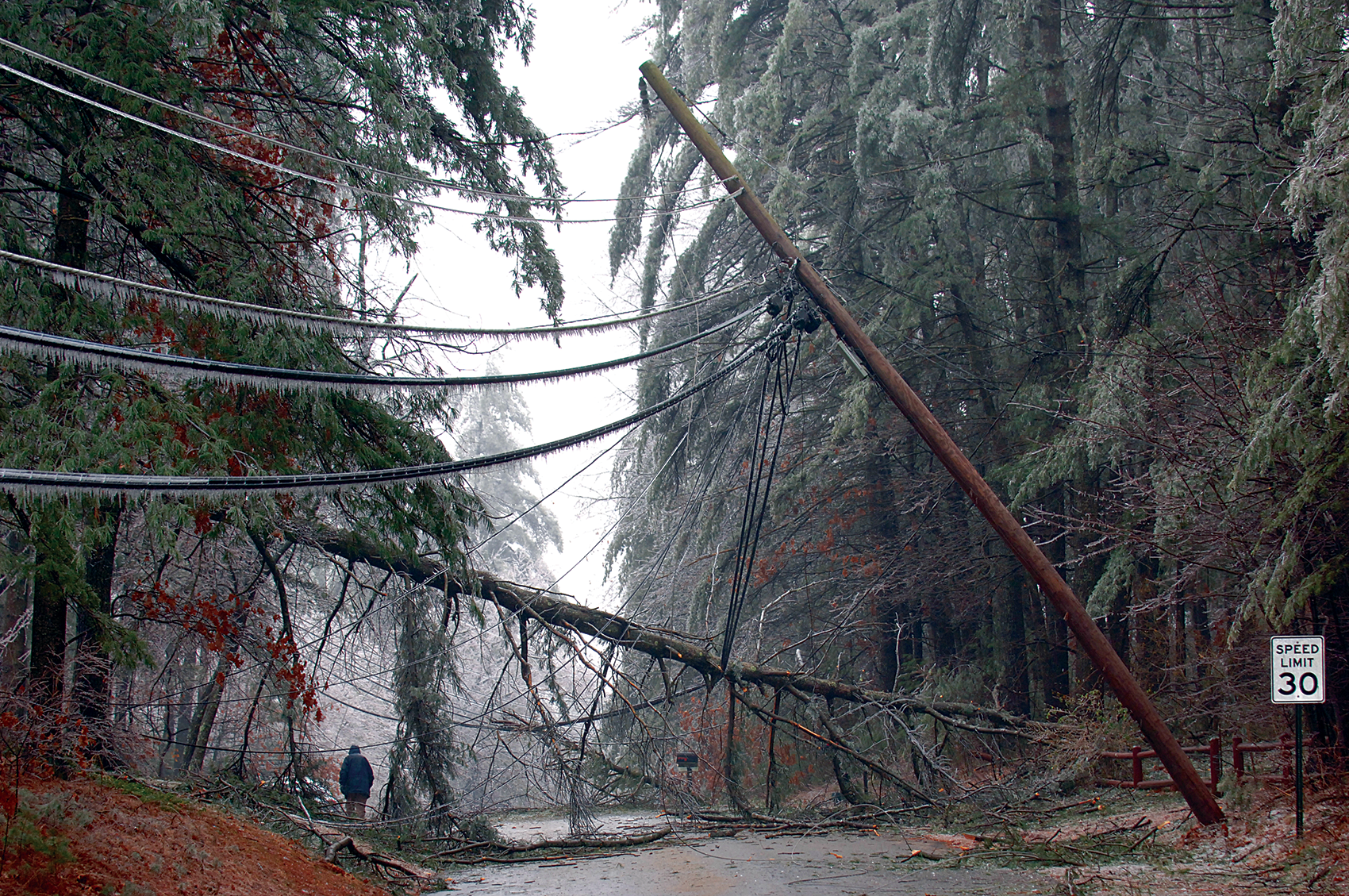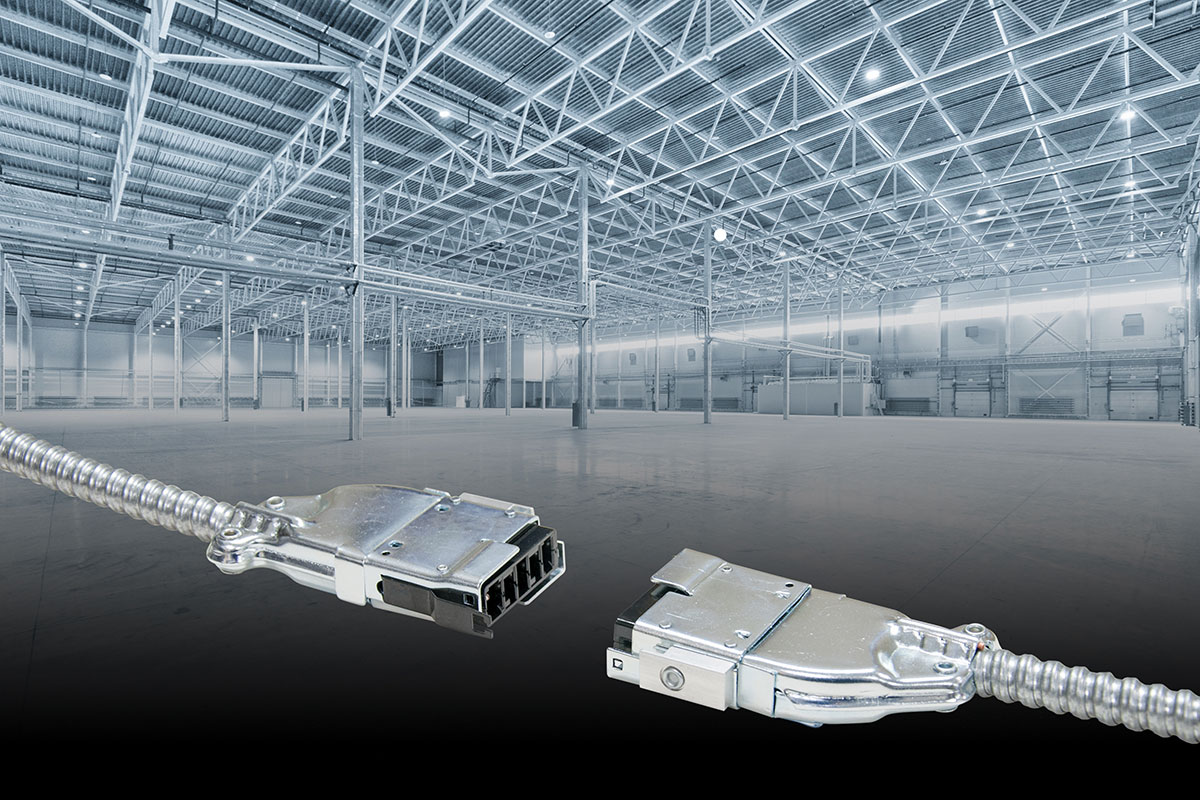Electrical hazards quickly multiply for workers involved in cleanup and recovery efforts following major disasters and weather emergencies. Life-threatening danger exists around downed and low-hanging electrical wires, which can still be energized following a storm.
Tree Care
Contact with electricity is one of the leading causes of death for tree care workers. Here are just a few examples of electrocutions that could have been prevented:
- A 26-year-old landscaper1 was electrocuted while trimming tree branches from a portable work platform. He had been using a pole saw to trim tree branches. The pole saw came in contact with the energized overhead power lines, and he was electrocuted and then ignited. There were no co-workers or supervisors on the site when the incident happened. He died later that day of his injuries.
- A tree trimmer was electrocuted2 while trimming tree branches in a residential front yard. He was hired by a homeowner to trim the branches of a tree that was growing into utility lines. He was attached to the tree with climbing spurs and fall protection while cutting the branch with a chain saw. The branch that was cut did not fully detach from the tree and struck the energized power line, sending an electric current into the victim’s body. The investigation determined that the worker had not followed requirements on line clearance and proximity to energized lines.
- In New Jersey, a 21-year-old landscaper3 was electrocuted when a felled tree landed on an overhead power line and caused the power line to drop. The investigation determined that the family-owned business had no written safety and health policy.
Don’t become part of a tragic headline. Be sure that you and your employees know the risks of tree work near sources of electricity.
Safety First
Always consider all electrical equipment, lines, and conductors to be energized. If you notice downed wires or damaged electrical equipment, contact appropriate utility personnel if you can. Circuits do not always turn off when a power line falls into a tree or onto the ground. Reclosures automatically try to reset circuits and restore power when it is interrupted. Even if electric lines are not sparking or humming, fallen electric lines can electrocute you if you touch them or the ground nearby.
Energy
Downed wires can energize other nearby objects, such as fences, water pipes, bushes and trees, buildings, and telephone/CATV/ fiber optic cables. Even maintenance hole castings and reinforcement bars (rebar) in pavement can become energized by downed wires. During storms, wind-blown objects such as canopies, aluminum roofs, siding, and sheds can also be energized by downed wires.
Backfeed
The improper connection of portable generators to a building’s electrical system is one way hazardous backfeed conditions are created!
Backfeed is a hazardous condition created when temporary sources of electricity (such as a generator) are connected to the damaged permanent system causing electricity to flow inside and outside a structure through connected lines and equipment. In emergency conditions, portable generators should only be used as standalone sources of power, and (except for properly wired by-pass or isolation connections) not connected to a building’s electrical system. If a generator is connected to a building’s electrical system, it must be done with a properly installed main breaker bypass to prevent electricity from flowing out of the building and into downed power lines.
Some other sources of backfeed include:
- circuit ties/switch points;
- lightning; and
- downstream events.
Always ensure that proper lockout/tagout procedures are followed to avoid connecting two electrical sources to the same circuit.

Rules to Live By
- Do not assume that a downed power line is safe simply because it is on the ground or it is not sparking.
- Do not assume that any wire is a harmless telephone, television, or fiber-optic cable, and does not carry lethal current.
- Treat everything electrical as energized until tested and proven to be de-energized.
- Never go near a downed or fallen electric power line.
- Electricity can spread outward through the ground in a circular shape from the point of contact. As you move away from the center, large differences in voltages can be created.
- Never drive over downed power lines. Assume that they are energized.
- If contact is made with an energized power line while you are in a vehicle, remain calm, and do not get out unless the vehicle is on fire. If possible, call for help.
- If you must exit any equipment because of fire or other safety reasons, try to jump completely clear, making sure that you do not touch the equipment and the ground at the same time. Land with both feet together and shuffle away in small steps to minimize the path of electric current and avoid electrical shock. Be careful to maintain your balance.
Be Prepared
- Train workers about potential hazards in a language that they understand.
- Before any work begins, survey the area for hazards.
- Have an emergency plan.
- Electricity can travel through the ground in some cases where you don’t expect it — be sure that workers wear properly insulated footwear and other required personal protective equipment (PPE).
- Consider asking the utility company to de-energize nearby power lines.
Follow Safe Work Practices
- Maintain a distance of at least 10 feet from overhead lines (and more than 10 feet if the voltage to ground is over 50 kV [see 29 CFR 1910.333(c)(3)(i)]; workers should not rely solely on protective clothing to protect against electrical hazards.
- Ensure that workers have no direct contact with an energized conductor, such as a power line.
- Ensure there is no indirect contact with an energized conductor, such as a tree limb or tool touching a power line.
- Ensure that workers are not standing close to grounding elements. The power can travel through the ground.
Provide the Right Gear
- Employers must provide proper gloves and shoes for hazards present where tree work is being performed.
- When electrical hazards are present, employers must also provide rope that is free of moisture and contaminants, and that provides appropriate insulation.
- Always provide fall protection for climbers.
Be Alert Around Downed Power Wires
- Assume that all lines are energized at all times.
- Anticipate when limbs might fall onto power sources.
- It only takes a moment for a fatality to occur.
Employers that are hired to clear trees from power lines must follow applicable OSHA requirements. See, for example, 29 CFR 1910.268, 29 CFR 1910.269, and 29 CFR 1910 Subpart S. For more information about OSHA’s standards addressing the hazards associated with clearing trees from around power lines, see the latest update.
Remember, it is the employer’s responsibility to comply with OSHA rules and keep workers safe. It is also the responsibility of the employee to follow the policies set forth by the employer who is trying to conform to these OSHA requirements.
Workers’ Rights
Workers have the right to:
- Working conditions that do not pose a risk of serious harm.
- Receive information and training (in a language and vocabulary the worker understands) about workplace hazards, methods to prevent them, and the OSHA standards that apply to their workplace.
- Review records of work-related injuries and illnesses.
- File a complaint asking OSHA to inspect their workplace if they believe there is a serious hazard or that their employer is not following OSHA’s rules. OSHA will keep all identities confidential.
- Exercise their rights under the law without retaliation, including reporting an injury or raising health and safety concerns with their employer or OSHA. If a worker has been retaliated against for using their rights, they must file a complaint with OSHA as soon as possible, but no later than 30 days
How to Contact OSHA
Under the Occupational Safety and Health Act of 1970, employers are responsible for providing safe and healthful workplaces for their employees. OSHA’s role is to ensure these conditions for America’s working men and women by setting and enforcing standards and providing training, education, and assistance. For more information, visit www.osha.gov or call OSHA at 1-800-321-OSHA (6742), TTY 1-877- 889-5627.
References
- Landscaper Working from a Raised Portable Work Platform Was Electrocuted When a Pole Saw Contacts Overhead Power Line. Accessed from www.cdc.gov/niosh/face/stateface/ma/13MA019.html
- A Tree Trimmer is Electrocuted When a Tree Branch Falls onto Energized Electric Power Lines. Accessed from www.cdc.gov/niosh/face/stateface/ca/11CA003.html
- Landscaper Electrocuted and Two Workers Seriously Injured When a Felled Tree Landed on an Overhead Power Line. Accessed from www.cdc.gov/niosh/face/stateface/nj/01nj117.html
With the Occupational Safety and Health Act of 1970, Congress created the Occupational Safety and Health Administration (OSHA) to ensure safe and healthful working conditions for working men and women by setting and enforcing standards and by providing training, outreach, education, and assistance.











Find Us on Socials